HYGIENE RULES FOR MARKETING CHILLED MEAT CUTS
Chilled meat is usually kept for the sale in refrigerated display cabinets, either unwrapped or portioned and packaged for self-service outlets. Refrigerated display cabinets may have fan-assisted convection and/or natural convection. Fan-assisted types are better able to maintain a lower temperature as they are less affected by draughts. Cabinets should be stacked to maintain a good air flow around all meat (Fig. 119).
| 114. Cutting chops from the loin | 116. Splitting the rib along the backbone |
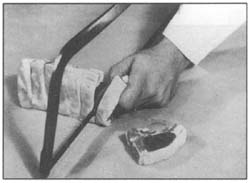 |
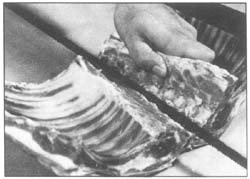 |
| 115. Removing the connective tissue covering the loin | 117. Rib chops and breast portion |
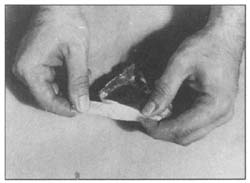 |
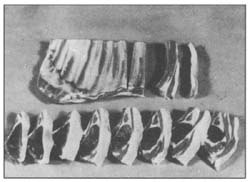 |
Do not store or display unwrapped cooked and raw meat together. Use separate refrigerators, display cabinets etc. to avoid cross-contamination. Raw-meat exudate on to cooked meat gives an explosive bacterial growth.
Simple packaging of fresh meat with plastic foil has become very popular with the availability of suitable and inexpensive film. The main objective of simple packaging is to provide hygienically protected portioned meat for self-service retail outlets. But the meat portions must also satisfy the customers’ preference for bright red fresh meat. This colour is due to the pigment myoglobin loosely binding oxygen to form oxymyoglobin. For this colour to develop and be maintained, the wrapping film must have a high-oxygen permeability. To avoid desiccation of the cut surface, the film should have a low-moisture permeability. After a time the cut surface becomes more brown as a result of myoglobin binding the oxygen more tightly to form metmyoglobin. This may take up to three days depending on the temperature, the number of bacteria and other conditions.
Simple packaging for retail sale in self-service outlets usually involves placing the meat portion in a plastic tray and overwrapping with a clear plastic film (Fig. 120). Plastic trays are more hygienic than cardboard. The portions cut should be based on local demand and only a day’s sales should be cut at a time.
| 118. Boneless shoulder (left) and ribs, backbone, blade- and armbone (right) | 119. Chill display cabinets should have a clearly visible thermometer which is set to 0°± 1°C. Meat trays should not be stacked on top of each other |
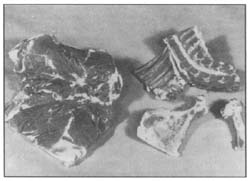 |
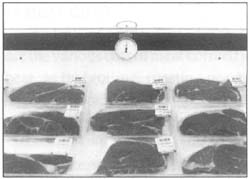 |
The principal object of this type of simple packaging from a hygiene point of view is to reduce contamination from airborne micro-organisms. High standards of hygiene are required in the cutting and packaging operations. On large pieces of meat the bacteria mainly colonize the outer surfaces. When meat is cut even with a clean knife they will be spread on to the freshly cut moist surface and multiply rapidly. This is not an argument for relaxing hygiene standards, rather it underlines the need not to add to the bacterial load by further contamination.
All surfaces and tools in the cutting and packaging room must be kept thoroughly clean. Packaging materials should be stored in hygienic conditions protected from dust and attack from insects or vermin. It is most important that personnel involved in cutting and packaging pay particular attention to personal hygiene as they are the most likely source of food-poisoning pathogens which may survive better in the package environment than on unpackaged meat. This is in part due to the packaging preventing surface desiccation. The moist surface favours bacterial growth as does the high relative humidity that builds up within the pack.
| 120. Overwrapping meat in a tray with clear film is a simple form of packaging suitable for self-service retail outlets | 121. Minced meat has a short shelf-life as the surface microorganisms are spread throughout the product and the surface area is increased |
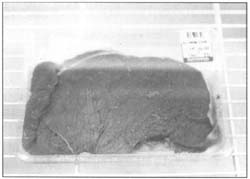 |
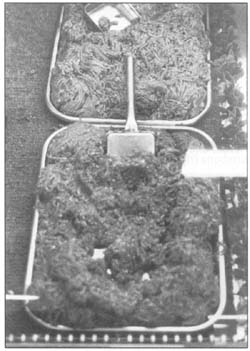 |
It is important to retard bacterial growth by maintaining a low temperature during the display life of the packs. Overwrapping actually increases the meat temperature as the layer of trapped air acts as an insulator. Heat generated by light warms the upper surface. Meat should be thoroughly cooled before packaging to help maintain a low temperature during its display life.
Mincing meat spreads bacteria on the surface all through the meat which therefore has a shorter shelf-life than cuts. Mince may be packaged and overwrapped but the mincer must be kept scrupulously clean and the packs kept well chilled (Fig. 121). Only small quantities of mince should be prepared at a time.
Cooked meats, which typically have much lower bacteria counts than fresh, are more open to attack from airborne micro-organisms as these will be faced with little competition. Packaging is therefore particularly beneficial in preventing this type of contamination for cooked meats.
Bacteria introduced during cutting and packaging face little competition and may be of the food-poisoning type if personal hygiene is poor. If very high standards of hygiene cannot be maintained then a pasteurizing treatment after packaging will be necessary. Even this, however, will not guarantee destroying Bacillus and Clostridium spp. if these have been introduced.
COOKING METHODS FOR DIFFERENT MEAT CUTS
Primarily because of natural tenderness or lack of tenderness, different cooking procedures are utilized to prepare the various cuts of meat correctly. Tender cuts are best cooked with dry heat, as by broiling, roasting or pan broiling. Less tender cuts are tenderized by cooking with moist heat. Connective tissue is softened and made tender by cooking slowly in moisture.
Temperature control is important in meat cookery. Meat loses moisture, fat and other substances such as soluble proteins during cooking. Cooking losses can be minimized by controlling the cooking temperature and the final internal temperature of the meat. Higher oven and higher internal temperatures increases shrinkage. Whenever possible a meat thermometer should be used to determine accurately the degree of doneness of meat. Time and temperature guides can be used to ascertain doneness, but cooking time is affected by fat, bone and moisture content and the shape and size of the cut. The basic types of meat cookery follow.
Broiling
Broiling is recommended for all tender cuts and for best results:
- Set the oven for broiling
- Place thin cuts of meat on a rack at a distance from the heat equal to two times the thickness of the cut plus 2.5 cm
- Broil steaks, chops or patties for approximately one-half the desired cooking time before turning
- Season and serve at once.
Pan-broiling
Pan-broiling is recommended for tender cuts suitable for broiling. For best results:
- Place meat in a hot frying-pan or on a griddle
- Do not add fat or water
- Cook slowly over moderate heat, turning occasionally
- Pour off or remove fat as it accumulates
- Brown meat on both sides
- Avoid overcooking.
Roasting
Roasting is recommended for large, tender cuts. Some beef cuts suitable for roasting are rib and top sirloin roasts. For best results:
- Season with salt and pepper as desired
- Place the meat, fat side up, on a rack in an open shallow roasting-pan
- Insert a meat thermometer so that the bulb is in the centre of the largest muscle without touching bone.
- Add no water and do not cover
- Roast at oven temperature of 176°C to desired internal temperature.Meats are usually cooked to degrees of doneness as follows:
– Rare 60°C – Medium 71°C – Well done 77°C
Pan-frying
Pan-frying is usually recommended for tender cuts 2.5 cm thick or less. For best results:
- Place meat in a hot frying-pan or on a griddle
- Fat may be added
- Cook slowly over moderate heat, turning occasionally
- Allow fat to accumulate
- Brown meat on both sides
- Avoid overcooking.
Braising
This method is best used for less tender cuts such as beef round or chuck steak, pot roast, stew or short ribs. For best results:
- Use a heavy pan
- If desired, brown meat slowly on all sides with sufficient fat to keep meat from sticking
- Season with salt, pepper, herbs or spices
- Add a small amount of liquid
- Cover tightly
- Cook slowly over low heat on a stove burner or in a moderate oven until meat is tender.
Braising with large cuts is often called pot-roasting and with thin cuts may be known as Swissing.
Simmering
This method consists of cooking a small amount of meat with a large amount of water. For best results the container should be tightly covered and the meat cooked slowly below the boiling point until tender. This method is used for the production of soups to which vegetables, grains or pasta products may be added.


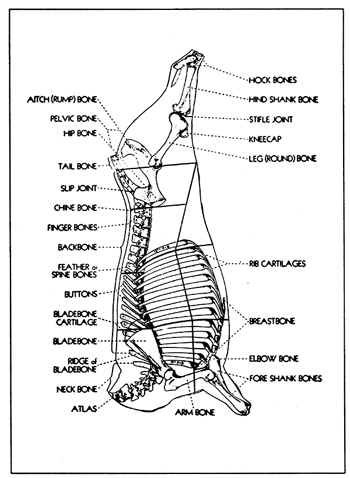
This is really nice to know. I hope it will be successful in the future. Good job on this and keep up the good work.
I am sure this post has touched all the internet people, its really really nice paragraph on building up new webpage.|
I’m really impressed with your writing skills as well as with the layout on your blog. Is this a paid theme or did you customize it yourself? Either way keep up the nice quality writing, it is rare to see a nice blog like this one nowadays..
Hi, I do think this is an excellent blog. I stumbledupon it 😉 I will come back once again since i have book-marked it. Money and freedom is the greatest way to change, may you be rich and continue to help other people.
By the Way, If you are looking to improve your web site with additional useful, interesting, internet search engine friendly content to create huge traffic and more profit, than I highly recommend you to visit this web site to along with the most vauable Article Marketing Tools. All the best – Ivelisse